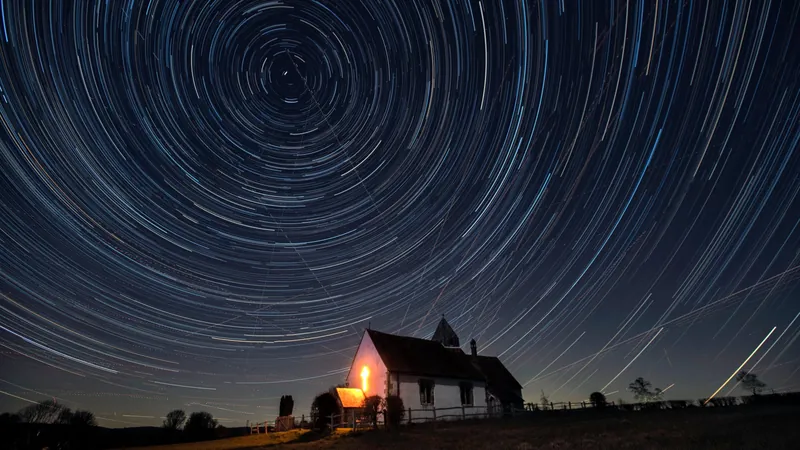
Is Polaris Always the North Star? Discover How Earth's 26,000-Year Cycle Redefines Our Guiding Light!
2025-05-20
Author: Kai
Polaris, famously known as the North Star or Pole Star, holds a significant place in our night sky. For centuries, it has been a reliable beacon for explorers navigating both terrestrial and celestial realms.
Located almost directly along Earth's north rotational axis, Polaris creates the illusion that the entire night sky revolves around it. However, it wasn’t always our North Star, and in the grand scheme of time, its reign will eventually come to an end.
Earth's relationship with the moon and sun causes a gravitational tug-of-war that results in axial precession, a wobble in Earth’s rotation over approximately 26,000 years. This phenomenon causes the celestial pole to trace a vast circle, bringing other notable stars into the spotlight as potential North Stars.
Curious about the past, present, and future of North Stars? Keep reading to uncover how to spot these celestial wonders yourself, plus recommendations for the best stargazing apps available in 2025.
1 - Polaris: The Reigning North Star
Polaris is the go-to star for anyone looking to navigate the night sky. Spotting it is simple: locate the Big Dipper in the Ursa Major constellation and draw an imaginary line from Merak through Dubhe. The next bright star you encounter is Polaris, a triple star system where one component burns over 2,000 times brighter than the sun!
2 - Thuban: The Ancient Star
Travel back in time to 4,700 years ago, when Thuban reigned as the North Star. Located about 270 light-years away in the constellation Draco, Thuban is part of a binary star system that occasionally eclipses, causing noticeable brightness dips. To find Thuban, follow similar steps used to locate Polaris, extending the line from Phecda through Megrez.
3 - Kochab and Pherkad: The Celestial Guardians
Around 3,000 years ago, Kochab and Pherkad were near the celestial pole, earning them the title of the 'Guardians of the Pole.' Their placement may have even influenced ancient Egyptians when aligning the Great Pyramids. By locating Polaris, you can easily find Kochab and Pherkad, nestled in Ursa Minor.
4 - Errai: The Future North Star
In just 2,200 years, Errai (Gamma Cephei) will take the crown as the North Star, positioned just 3 degrees from the celestial pole. This binary system is located 45 light-years away, and the primary star hosts a gas giant, further boosting its intrigue. To find Errai, extend the line from Dubhe through Polaris.
5 - Alderamin: Future Fame
Fast forward to 5,000 years from now, and Alderamin in Cepheus will shine as the North Star. Known for its distinctive house-like shape, this star can be located by drawing a line from Shedar through Caph in Cassiopeia.
6 - Deneb: Past and Future Icon
Deneb, once close to the celestial north pole 18,000 years ago, will again approach it around 9,800 CE. To spot Deneb, look east in the spring evenings; it’s one of the three stars forming the famous Summer Triangle.
7 - Vega: The Ancient Beacon
Vega, known for its brilliance, was once the North Star 14,000 years ago and will reclaim its title in approximately 12,000 years. Its massive protoplanetary disk was the first evidence of star formation, making Vega a notable celestial body.
For stargazing enthusiasts eager to explore the wonders of the night sky, 2025 is the year to invest in the right gear! Check out our guides on the best binoculars and telescopes, and dive into astrophotography with our camera recommendations!



 Brasil (PT)
Brasil (PT)
 Canada (EN)
Canada (EN)
 Chile (ES)
Chile (ES)
 Česko (CS)
Česko (CS)
 대한민국 (KO)
대한민국 (KO)
 España (ES)
España (ES)
 France (FR)
France (FR)
 Hong Kong (EN)
Hong Kong (EN)
 Italia (IT)
Italia (IT)
 日本 (JA)
日本 (JA)
 Magyarország (HU)
Magyarország (HU)
 Norge (NO)
Norge (NO)
 Polska (PL)
Polska (PL)
 Schweiz (DE)
Schweiz (DE)
 Singapore (EN)
Singapore (EN)
 Sverige (SV)
Sverige (SV)
 Suomi (FI)
Suomi (FI)
 Türkiye (TR)
Türkiye (TR)
 الإمارات العربية المتحدة (AR)
الإمارات العربية المتحدة (AR)